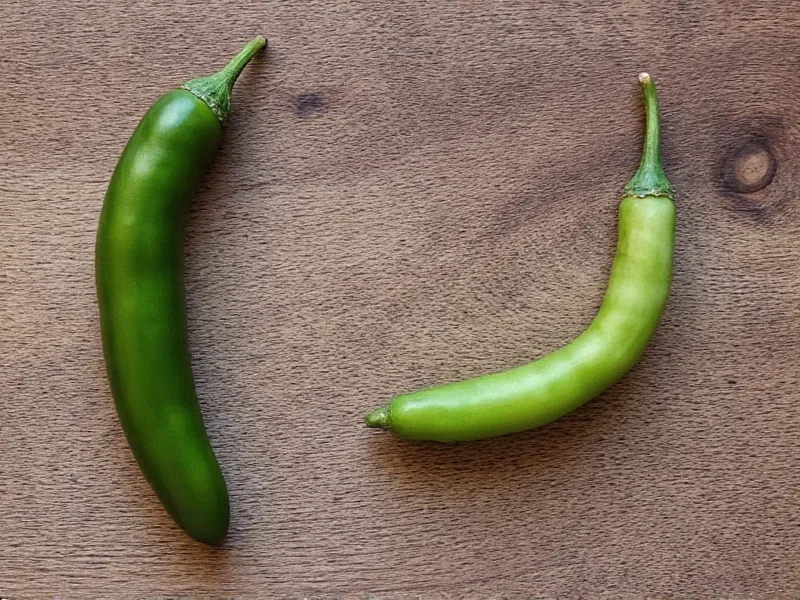When comparing whats hotter serrano or jalapeno, the answer is clear: serrano peppers pack substantially more heat. Understanding this difference is crucial for home cooks and culinary professionals who need to select the right pepper for their recipes without accidentally creating an inedibly spicy dish.
Understanding Pepper Heat Measurement
The Scoville scale, developed by pharmacist Wilbur Scoville in 1912, measures the concentration of capsaicinoids—the compounds responsible for a chili pepper's heat. While modern high-performance liquid chromatography provides more precise measurements today, the Scoville Heat Unit (SHU) remains the standard reference.
Serrano Pepper Profile
Serrano peppers (Capsicum annuum) originate from the mountainous regions of Mexico. These 1-4 inch long peppers typically appear bright green when immature, ripening to red, brown, orange, or yellow. Beyond their notable heat, serranos offer a bright, slightly grassy flavor with crisp texture.
Their heat range of 10,000-23,000 SHU places them firmly in the medium-to-hot category. For reference, this makes them:
- 2-3 times hotter than average jalapeños
- Milder than habaneros (100,000-350,000 SHU)
- Comparable to cayenne peppers in heat intensity
Jalapeño Pepper Profile
Jalapeños (Capsicum annuum) are among the most recognizable chili peppers worldwide. These 2-3.5 inch tapered peppers start green and mature to red. Their heat level ranges from 2,500 to 8,000 SHU, making them accessible for most palates while still providing noticeable spice.
Beyond heat, jalapeños offer a distinctive grassy, slightly sweet flavor profile. When smoked and dried, they become chipotles, which develop a complex smoky-sweet character while retaining moderate heat.
Direct Heat Comparison: Serrano vs Jalapeño
| Pepper Variety | Scoville Heat Units (SHU) | Relative Heat Level | Common Culinary Uses |
|---|---|---|---|
| Serrano | 10,000-23,000 | Medium-Hot | Salsas, guacamole, pickled peppers, hot sauces |
| Jalapeño | 2,500-8,000 | Mild-Medium | Stuffed peppers, nachos, poppers, fresh salsas, pickled jalapeños |
This serrano vs jalapeno heat comparison shows that even the mildest serrano (10,000 SHU) is hotter than the hottest jalapeño (8,000 SHU). In practical terms, substituting serranos for jalapeños without adjusting quantity will significantly increase a dish's spiciness.
Factors Affecting Pepper Heat Levels
Several variables influence the actual heat you'll experience with either pepper:
- Color maturity: Riper (redder) peppers tend to be hotter
- Growing conditions: Stress from less water or nutrient-deficient soil increases capsaicin production
- Individual variation: Even within the same plant, heat can vary significantly
- Preparation method: Removing seeds and white membranes reduces heat substantially
Culinary Implications of the Heat Difference
Understanding how much hotter is serrano than jalapeno matters for recipe success. When substituting:
- Use 1 serrano pepper for every 2-3 jalapeños called for in a recipe
- Add serranos gradually, tasting as you go
- Consider removing seeds and membranes from serranos for milder results
- Remember that cooking can concentrate heat as water evaporates
The flavor difference also matters—serranos offer a cleaner, brighter heat while jalapeños provide more vegetal, grassy notes. This makes serranos better for fresh salsas where you want pronounced heat, while jalapeños work well in dishes where moderate spice with distinctive flavor is desired.
Safe Handling Practices for Hotter Peppers
When working with serranos, which are significantly hotter than jalapeños, follow these safety tips:
- Wear gloves to prevent capsaicin transfer to sensitive areas
- Avoid touching your face while handling hot peppers
- Wash hands thoroughly with soap after handling, even with gloves
- Use separate cutting boards for hot peppers
- If experiencing burning sensation, use dairy products (milk, yogurt) rather than water to neutralize capsaicin
When to Choose Serrano Over Jalapeño
Select serranos when you need:
- More pronounced heat in fresh salsas or guacamole
- A cleaner, brighter pepper flavor without jalapeño's grassiness
- Peppers for pickling that will maintain crisp texture
- Hotter base for homemade hot sauces
Choose jalapeños when you prefer:
- Milder heat that won't overwhelm other flavors
- Distinctive grassy flavor profile
- Peppers for stuffing (their larger size and thicker walls work better)
- Beginner-friendly heat for those sensitive to spice











 浙公网安备
33010002000092号
浙公网安备
33010002000092号 浙B2-20120091-4
浙B2-20120091-4